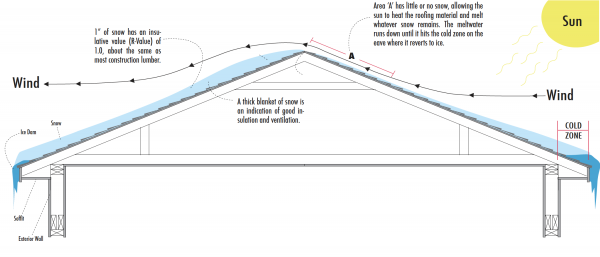Snow Distribution and Ice Dams
How the Distribution of Snow Can Affect the Formation of Ice Dams
Snow and Ice Dams
There is a complex relationship between snow and ice dams. Yes, you need snow to get ice dams. Snow is, after all, the fuel that feeds the formation and growth of ice dams. Furthermore, it is unlikely to get ice dams unless there is an ongoing layer of snow on your roof over a period of time (normally at least 7-10 days). But it takes more than just having snow on your roof to get ice dams. See Ice Dam Company Case Study #23 for a list of contributing factors. One factor that seldom gets discussed is the affect of wind on the formation and severity of ice dams. While this is not a primary factor, it is something worth exploring. This Ice Dam Case Study looks at the affect a thinning snow cover has when seen on a roof slope that also faces the sun. The affect described below is exacerbated by the presence of darker roofing materials as they absorb more solar energy than lighter materials.
Mountains and Roofs Share Something in Common
Any skiers out there? Wind speeds increase near the ridge of a roof just like the top of a mountain. Snow on one side of the ridge is often swept away while remaining in place just on the other side of the peak. This phenomenon can affect both sides of a roof if wind direction changes from day to day, leaving the snow coverage thin or non-existent on the upper few feet of the roof below the ridge.

Condensation, The Silent Killer
The lack of an insulating snow blanket can allow heat from the inside of the home to meet cold exterior air in a thinner ‘conduction plane’. When heat hits a thin surface such as a roof decking, where there is a great temperature differential from one side to the other, condensation is also likely. Think of frost on old, single paned windows. The more space there is between the heat and cold, the more room there is for this interaction, greatly reducing the likelihood of condensation. A thick blanket of snow is a perfect insulator for this purpose. It creates more separation between the warmth being lost from the home and the frigid exterior air. Homes with thick snow coverage on their roofs generally seen as more efficient because heat is not escaping through the roofline to reduce the snow through melting.
To read more Case Studies click here.
Tags: about ice dams, best ice dam removal in minneapolis, best rated ice dam removal contractor, highest rated ice dam removal company in minneapolis, how do I know I have ice dams, how to tell if an ice dam is a problem, ice and snow removal, ice dam expert, ice dam removal jerks, ice removal company, minneapolis ie dam removal, steamer





